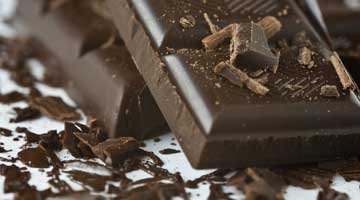 Updated with an email from Daniel Hossley, Moonstruck CEO below.
Updated with an email from Daniel Hossley, Moonstruck CEO below.
As You Sow, a company which promotes environmental and social corporate responsibility, has found levels of lead or cadmium (another heavy metal) above California’s maximum allowed level in multiple chocolate products, including Portland’s own Moonstruck Chocolate. You have probably seen many of these available on store shelves: Ghirardelli, Godiva, Hershey, Moonstruck Chocolate Co., Dagoba, Theo Organic (Seattle), Trader Joe’s and Whole Food’s 365. The bulk of the selections which exceeded limits were dark chocolates, with the exception of Trader Joe’s where six different versions were found to have more than the limit.
California has very strict limits for lead and cadmium in food products. Some of the chocolate tested contained lead at levels up to 5.9 times the maximum allowable daily limit, and found cadmium at levels up to 8.2 times the limit.
According to the notices filed with the California’s Attorney General by As You Sow, the companies failed to provide a warning label as legally required by the state. Though some of the products have very low levels, under California’s Proposition 65, products with more than .05 micrograms of lead must be labeled as such.
According to the article,
No level of lead is safe for children. Lead exposure has been a significant public health issue for decades and is associated with neurological impairment, such as learning disabilities and lower IQ, even at low levels. “No amount of lead ingestion is ‘safe’ for children,” states Sean Palfrey, MD, a pediatrician and professor of Pediatrics and Public Health at Boston University School of Medicine. “Pregnant women and young children with developing brains in particular should avoid any ingestion of lead.”
Cadmium is also known to cause reproductive harm. Chronic exposure to cadmium has been to kidney, liver, and bone damage in humans. Children are more susceptible to exposure effects from low doses of cadmium over time. Companies are not doing enough to keep their products safe and below California’s safe harbor level for reproductive harm for these toxic heavy metals.
“Lead exposure has been a significant public health issue for decades and is associated with neurological impairment, such as learning disabilities and lower IQ, even at low levels. “No amount of lead ingestion is ‘safe’ for children,” commented Sean Palfrey, MD, a practicing pediatrician and professor of Pediatrics and Public Health at Boston University School of Medicine. “Pregnant women and young children with developing brains in particular should avoid any ingestion of lead.”
Chronic exposure to cadmium has been linked to kidney, liver, and bone damage in humans. Children are more susceptible to exposure effects from low doses of cadmium over time. Animal studies have associated cadmium exposure with decreased birth weight, neurobehavioral problems, and male reproductive harm.
Consumers need to know that chocolate may contain heavy metals,” said Eleanne van Vliet, MPH, As You Sow’s Toxic Chemical Research Director. “Since lead and cadmium accumulate in the body over time, even small amounts should be avoided.”
Civil Eats.com researched the possible sources of the lead/cadmium.
“How do these heavy metals get into chocolate in the first place? Scientists point to environmental contamination, primarily of soil, as a likely culprit. But air pollution may also be a factor as cacao beans are often dried outdoors. A 2005 study found high levels of lead in chocolate sourced from Nigeria. The authors suspected that air and soil contamination from leaded gasoline were to blame. It’s also thought that lead may enter at other points in the chocolate manufacturing practice.
Meanwhile, the industry group Responsible Cocoa, an international coalition of chocolate manufacturers that works in the U.S. with the National Confectioners Association, says that “most of the naturally-occurring lead is in the cacao bean shell, which is removed during processing.” It also notes that “FDA and other health authorities have determined that tiny traces of naturally occurring heavy metals in foods are unavoidable and present no public health risk.”
updated:
Daniel Hossley, CEO at Moonstruck Chocolate dropped me a note after this first posted:
At Moonstruck Chocolate Co., customer safety has always been our top concern, and we want to assure our customers that our products continue to be safe. Our chocolates comply with all regulations from the Food and Drug Administration and individual states, including California’s strict Proposition 65 labeling requirements for lead.
Contrary to some published reports, Proposition 65 does not apply to low levels of chemicals in food that are deemed “naturally occurring” within the meaning of California Code of Regulations. Under this regulation, producers are not responsible for “naturally occurring chemicals” in foods if certain criteria are met. This regulation was designed to avoid ubiquitous warnings on many foods due to the existence of small quantities of some chemicals in the air, ground, and water, which results in their being present in food.
The Food and Drug Administration and other health authorities have determined that these tiny traces of naturally occurring metals in foods are unavoidable and present no public health risk. In fact, the Attorney General declined to move forward with a similar suit brought against the industry by another group in 2001.
Additionally, Moonstruck Chocolate Co. purchases products from reputable suppliers who employ strict quality control measures to monitor and reduce the content of these metals to the lowest levels currently feasible.
I have some additional information he sent me on the subject. If you are interested, drop me an email and I’ll be happy to send it to you.
Bryan Concannon/ Refugee education Project says
Can you send me the additional information from Moonstruck CEO you have on the Lead/ cadmium issue.
PDX Food Dude says
Hi Bryan. That was so long ago I don’t have the information you want. Also, I think Moonstruck was in 2021.